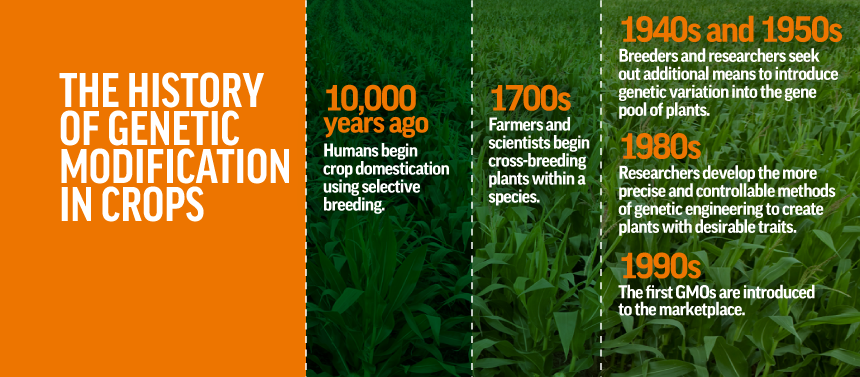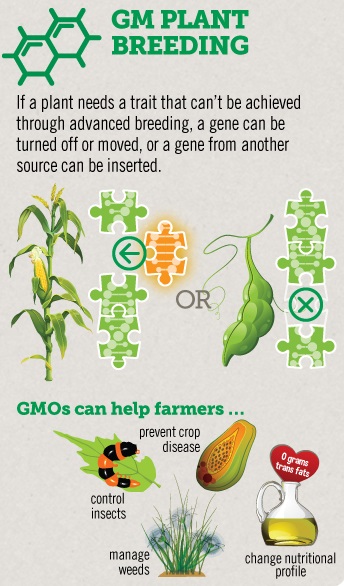Question
How were GMOs created?
Submitted by: bnt9585
Answer
Expert response from Community Manager
Moderator for GMOAnswers.com
Monday, 04/04/2016 19:04
Genetically modified organisms (GMOs) are crops developed with a process called genetic engineering. The process of genetic engineering did not start in agriculture. It was first developed in the early 1970s, commercialized for pharmaceutical applications in the early 1980s, and then agricultural applications in the early 1990s. Chris Barbey, PhD student at the University of Florida, explains GE technology for pharmaceutical applications in this blog post here, If you were a diabetic before the 1980’s, to stay alive you needed injections of insulin processed from the pancreases of slaughtered livestock. These insulin preparations were expensive, and sometimes didn’t work well or caused allergic reactions due to impurity. The first-ever FDA approval of a genetically engineered organism solved all of these problems. Using essentially the same techniques we use to improve crops, the human insulin gene was installed in yeast. These genetically engineered yeast produce huge amounts of 100% human insulin that are easily purified, both increasing safety and reducing cost to the patient. Today, we’ve even improved on medicinal insulin by engineering small mutations that tailor its effects to different kinds of people. Personalized medicines like this hold the potential to vastly improve human health.”<
With regard to GMOs in agriculture, following is a brief history of crop modification and how we arrived at the GMO crops we have today in modern agriculture.
Farmers have intentionally changed the genetic makeup of all the crops they have grown and the livestock they have raised since domestic agriculture began 10,000 years ago. Every fruit, vegetable and grain that is commercially available today has been altered by human hands, including organic and heirloom seeds. Without plant breeding of any kind, we would have corn kernels that you would have to crack open with a rock; a banana that is difficult to peel and full of seeds; and broccoli that no amount of cheese could make edible.

There are many breeding techniques utilized in modern agriculture including selective breeding, mutagenesis and genetic engineering, among others. Each of these techniques may be used to develop a new plant variety, sometimes in a continuum over many years. For example, seeds developed through selective breeding may be altered through mutagenesis and then altered again using genetic engineering. In the late 20th century, advances in technology enabled us to expand on this knowledge of crop modification through genetic engineering. For years, university, government and company scientists intensively researched and refined this process, a major result of this was GMO seeds.
This matrix provides an overview of the different techniques used in modern agriculture.
Genetic engineering in agriculture enables plant breeders to take individual traits found in nature and transfer them to another plant, or make changes to an existing trait in a plant. While genetic engineering is the latest technique used in the long evolution of plant breeding, it differs from other techniques by enabling specific, more predictable changes to be made to a plant.

GMOs Today
Today, nine crops from GM seeds are commercially available in the United States. These crops are corn (field and sweet), soybeans, cotton, canola, alfalfa, sugar beets, papaya, potatoes and squash. A GMO Apple is approved and coming to market soon. Below is a table outlining what year these nine crops became available commercially:
|
Squash |
1995 |
|
Cotton |
1996 |
|
Soybean |
1995 |
|
Corn |
1996 |
|
Papaya |
1997 |
|
Alfalfa |
2006 |
|
Sugar beets |
2006 |
|
Canola |
1999 |
|
Potato |
2016 |
CASE STUDY: EVOLUTION OF CORN
Let’s take a look at how modern corn came to be, as this particular crop has a very interesting background. About 10,000 years ago farmers in what is now Mexico took the first steps to domesticate corn by simply choosing the most desirable kernels from a plant called “teosinte” – a plant that eventually evolved into modern day corn. Today, corn now provides about 21 percent of human nutrition across the globe. Over the past century, corn has evolved with the availability of hybrid corn in the 1930s and the planting of GM crops in the mid-1990s. Due to the insect resistance and/or herbicide tolerance of GM corn, more and more of it was planted. Contrary to popular belief, the development and increased usage of GM corn has not changed the physical appearance of corn. What has changed, due to modern plant breeding, is size, consistency, seed performance, yield, the number of ears per stalk, and the position of the ear and the leaves on the stalk. Currently, a plant has only one ear located about waist high (the height of a combine blade), and its leaves grow at a more upright angle to better catch sunrays and rain. A century ago, farmers planted about 8,000 corn plants per acre. Today they plant about four times as many plants per acre.

To better understand why GMOs were initially created and the evolution of crop modification we encourage you to read more here.
This video also explains how GMOs are created. And this video provides an overview of the “life” of a GMO seed.
See how crops have evolved from ancient Egypt until today in this infographic from European Biotech Week, and then journey through the last 80 years of modern agriculture with this video.
Additionally, in these responses, Bobby Williams, senior research manager at DuPont, and Patrick Walker, scientist at BASF Plant Science, explain how and what breeding techniques are used to develop GMOs. We hope the information provided answers your question. If you have any further questions, please ask. Also, feel free to contribute to the discussion in the comment section below!